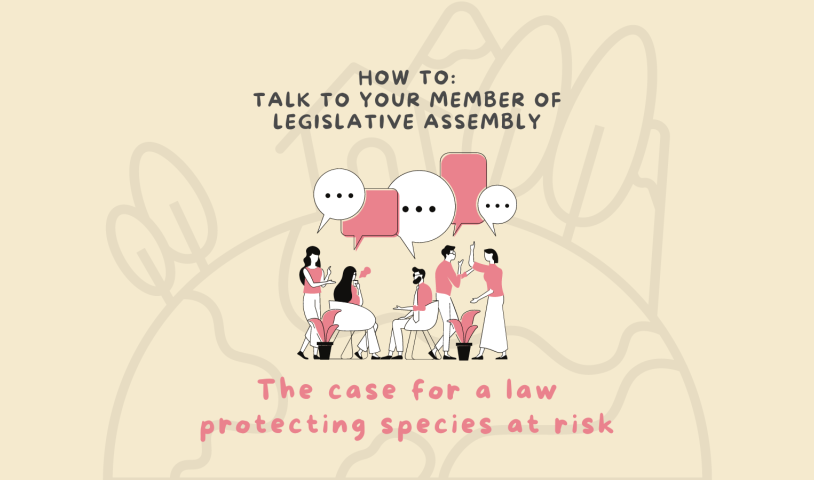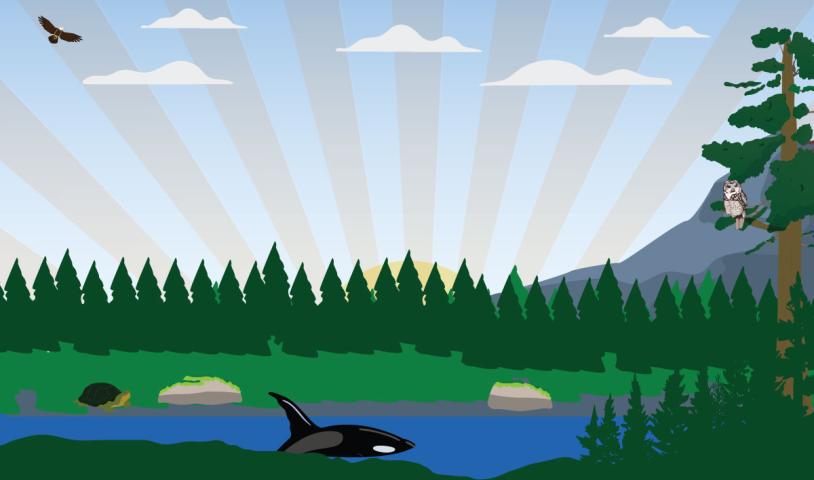The case for a law protecting species at risk in BC
Thursday, September 1, 2022
A guide for talking to government about endangered species
Have you landed a meeting with your MLA? Waiting to hear back about one? Exchanging emails with your representative or a member of their staff?
You’re in the right place.
Whether you’re planning to ramp up pressure on the government or just looking to learn more, this resource is for you. We’ve created this document to help cut through the noise and prepare for some of the common responses we can expect from elected officials when we ask for a law to protect species at risk.
It’s important to showcase your understanding of the biodiversity crisis and remind elected officials of its importance and urgency.
Points to make
- We are in a biodiversity crisis and must take action to prevent biodiversity loss. The focus of the upcoming United Nations Biodiversity Conference (COP 15) in Montreal is protecting nature and halting biodiversity loss worldwide.
- As countries worldwide prepare to set intentions and goals, the BC government must reconcile that change is needed to live up to international commitments on biodiversity protection. In BC, 1,900 species and subspecies are at risk of extinction. Without additional policies in BC to change the status quo, we will not be able to halt biodiversity loss.
State your ask clearly
Here’s an example:
"I’m asking your government to enact standalone provincial legislation to protect species at risk and native ecosystems by 2024. I’m asking you to finish the well-intentioned law that you started, as this was part of the environment minister’s 2017 mandate. The government halted the creation of the law in 2019 and the crisis has only worsened. In BC, many species are declining rapidly, and ecosystems are breaking down around us in the form of flooding, heat domes, severe fires and landslides. Enacting a law has been supported by the Union of BC Indian Chiefs in 2020, many academic scientists, over 40,000 people who signed a petition for a law, and many of your fellow MLAs."
State how this law will help the government achieve commitments
Enacting legislation is an opportunity for your government to fulfill commitments under all three ministries:
- The BC government committed to the Old Growth Strategic Review recommendations which included recommendation number two — to enact legislation that makes ecosystem health and biodiversity a priority across all sectors. The government has already committed to overarching legislation and must fulfill this promise.
- The 2022 mandate letter for the Ministry of Land, Water and Resource Stewardship states to protect species at risk and enhance biodiversity.
- The 2022 mandate letter for the Ministry of Environment and Climate Change states to also work on species at risk protection.
- A law would finally fulfill the 2017 failed Ministry of Environment and Climate Change mandate to create a law.
Highlight that the public supports action on species at risk protection
- Seven in 10 residents of BC support the government setting big and important nature conservation goals in 2022.
- Three out of four BC residents would be more likely to support protecting wilderness when First Nations and local communities are involved.
- 84 per cent of British Columbians support taking action to keep wildlife safe.
- 40,000 British Columbians have taken action to support this law.
CLAIMS TO WATCH OUT FOR
There are some claims the government might make to bypass the importance and necessity of a law. Here are some of those claims and what you could say to argue for a better species law.
Claim #1: The federal species at risk act does a good enough job at protecting species at risk in BC
The federal Species at Risk Act (SARA) has problematic loopholes. The federal species at risk act only automatically applies to marine species, migratory birds or species on federal land (national parks, military bases, post offices and airports). In BC, non-federal land makes up 94 per cent of the land base. So throughout all non-federal land, even in provincial parks, SARA gives responsibility to the provinces and territories. SARA only functions effectively if all provinces and territories have their own standalone laws to provide equal protection to species and their habitat on non-federal land.
Since BC does not have provincial legislation to protect species at risk, it fails to offer protection for species at risk. For example, logging corporations get away with destroying critical habitat for the marbled murrelet, southern mountain caribou, and Williamson’s sapsucker, to name a few. When provinces and territories fail to protect species at risk on non-federal land, the federal government has legal options to step in, but they rarely do. Astonishingly, Canada has only issued an emergency order to protect habitat on non-federal land twice. Wildlife in BC is falling through the legal cracks. A provincial law would fill in these cracks.
Claim #2: Other provincial laws include the protection of species at risk
Biodiversity and species at risk protection can only be achieved from an overarching law that manages all industries so they’re held to the same standards of protection. Currently, various laws mention species at risk. They provide some small ways to protect species from the specific industries they manage. Yet, these laws do not apply to all industries and projects that cause harm to species and risk. Secondly, they do not offer the same protection as required under SARA. Here are two examples of some of the shortcomings of laws that mention species at risk protection:
- Wildlife Act – This law is used to regulate the hunting of animals. There is a section dedicated to species at risk protection but it only lists and protects four species. Whereas the BC Conservation Data Centre lists 1,900 species and subspecies at risk of extinction.
- The Forest and Range Practices Act (FRPA) – This act allows the creation of some objectives to support wildlife. But until recently these objectives could not unduly impact timber supply — no more than 1- 4.5 per cent of timber supply could be impacted by species protection. Even with this clause removed, it's still up to the government's chief forester to weigh objectives like increasing production and supply of timber. Often protection of species critical habitat is the least on the priority list of the chief forester. FRPA treats species at risk as a constraint to be managed and so the logging industry is often responsible for extensive critical habitat destruction.
There needs to be an overarching law that aligns all industries and sets standards for species at risk protection.
Claim #3: BC is one of the leaders in species at risk protection
BC is falling behind as most provinces and territories in Canada have standalone laws to protect species at risk, ecosystems or biodiversity in some form. Seven provinces and territories have laws of their own to protect species at risk, ecosystems and biodiversity in some form. Ontario created its endangered species law in 2007.
British Columbia has more biodiversity than any other province or territory in Canada, but also the most species at risk. There is no law to protect biodiversity and save species at risk. We have the most to lose regarding biodiversity and the most to gain. If we were doing enough to protect species at risk here, spotted owls wouldn't be down to just one pair, and six southern mountain caribou herds would not have gone extinct in recent years.
ASK FOR FOLLOW-UP
Ask your MLA to bring this issue to the attention of the premier and ministers. Ask your MLA to provide you with a timeline of when this law can be expected. If they cannot answer these questions during the meeting, ask them to get back to you.
Make a phone call to your MLA for biodiversity





